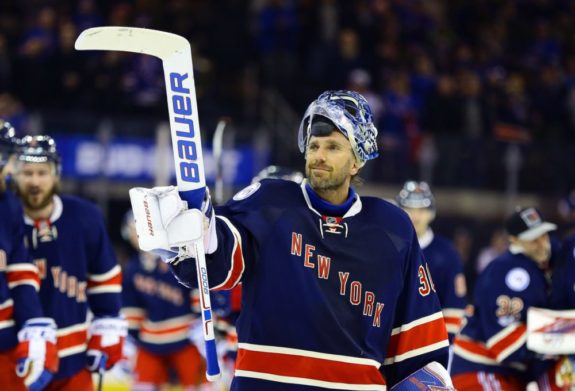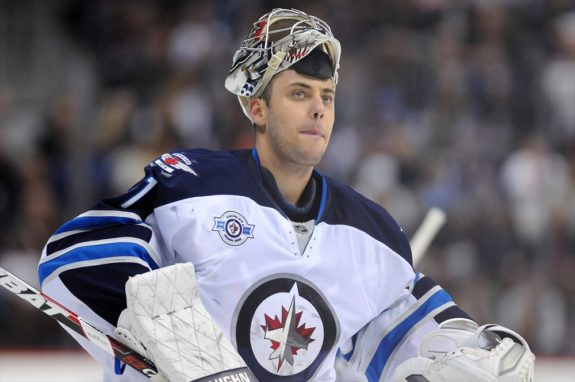Henrik Lundqvist had a down year last season. There is no other way to put it. The years where he is dominating the league are likely behind him now at the age of 35. However, there is no reason he can’t improve on his below-par campaign from last year.
For the first time in his career, Lundqvist struggled last season. He went through spells of inconsistency where he looked downright ordinary. This was not the Lundqvist Rangers fans were accustomed to seeing. This was pedestrian Lundqvist. A mortal King Henrik. And it was a shock to the system. But more importantly, it was a reality check on the longevity of athletes. We all knew this day was coming. And now that it is finally here, what do we do? What should we expect this season from the man nicknamed “The King?”

I expect Lundqvist to rebound. He has built his career proving people wrong. A seventh-round pick from Sweden turned his career into one worthy of the Hall of Fame. Now, with all eyes on the closing window of his career, pundits and fans alike are wondering if he can still win a Stanley Cup. Well, he still has a chance to prove the doubters wrong one last time.
The Importance of Pavelec
At Lundqvist’s advanced age, having a solid back-up is vital. Last season, Antti Raanta had back-up duty in New York and performed admirably in that role. He started 26 games, appearing in 30 altogether, and posted 2.26 goals against average (GAA) and a .922 save percentage (Sv%) to go along with four shutouts.
The Rangers capitalized on Raanta’s impressive campaign and traded him to Arizona. They sent him there along with Derek Stepan over the summer to land the number seven overall pick and young defenseman Anthony DeAngelo. That number seven pick turned into Lias Andersson, who competed for an opening night roster spot during the preseason, but ended up being sent to Sweden for now. As for Anthony DeAngelo, he made the final roster cuts and put himself in contention to start Thursday night.
Good for Raanta to get a starting job, but his hole meant the Rangers needed a new backup tender. For this upcoming season, the Rangers signed veteran Ondrej Pavelec to a 1-year, $1.3 million deal. A cap friendly move for a Rangers team that is constantly working near the salary cap limit.

Pavelec has had an up and down career in the NHL. Last season, he started the year in the AHL at Manitoba and ended up only starting eight games for the Winnipeg Jets all season. In those eight games, he posted a 3.55 GAA and a .888 Sv%. Those numbers are, well, uninspiring to say the least.
However, if you look at his stats from three seasons ago, there is reason for hope. In the 2014-15 season, Pavelec posted career bests in goals against (2.28), save percentage (.920), and shutouts (5). These stats were en route to a record of 22-16-8 in 46 games started (50 appearances) and a playoff berth for the Jets. This is significant, because that was the only season where Pavelec played in the postseason. Sometimes, a goalie is only as good as the team in front of him. This season in New York, he will be on what should be a very solid Rangers team, so he likely won’t be left in too many compromising situations.
Hank’s Crazy Workload
Lundqvist is a workhorse and a competitor of the highest order. He wants to be out there for every game. He has a legendary work ethic dating back to his rookie season on the Rangers.
Lundqvist was not the anointed starter in his rookie season, but eventually won the starting job from Kevin Weekes and never looked back. Over the next five seasons, Lundqvist started 67 or more games in each season. Added all up, he started 350 times in 410 regular season games. That’s good for an 85% start rate.
And it is not like he slowed down much following that span. From the start of the 2011 season to the end of the 2016 season, he started 277 games out of a possible 351. That’s if you exclude the 25 games he missed due to a freak injury in 2015 when he took a puck to the throat. Also during this span was the strike-shortened season of only 48 games. With that all said, he started 79 percent of regular season games (73 percent if you count those injured games in the equation). Any way you slice it, that is a lot of starts.
Oh, and let’s not forget about all his playoff starts. In his career, he has started 128 of their 131 games. And playoff games are not like regular games. The stress and pressure are immensely higher. These added games take their toll and no question will ultimately impact the length of Lundqvist’s career.
Which finally brings us to last season. A career worst for Lundqvist. A season that saw him manage just a .910 Sv% and a whopping 2.74 GAA. His previous high in goals against was 2.48, which came during the 2015-16 season campaign. So the decline is happening.
But knowing Lundqvist, he is going to work hard to improve his game. I don’t expect him to return to his Vezina-form years, but I do expect his regular season stats to improve from last season.
How to Improve
To keep Lundqvist sharp come April, they should limit his starts in the regular season. The number where Lundqvist was at last season (55) is a good barometer of where they should go with him this season, as well. Despite his sub par regular season, Lundqvist showed sparkling form during the playoffs.
In 12 playoff games, Lundqvist had a 2.25 GAA to go along with a .927 Sv%. A lot can be attributed to the Rangers playing well as a whole during this stretch, but Lundqvist simply looked much sharper than he did in the regular season and perhaps only playing in 55 games helped.
However, this means the Rangers will need Pavelec to count for roughly 25-30 starts this upcoming season. For years, the Rangers relied on a dominating regular season from Lundqvist to even make the playoffs. That is not the case anymore. For the most part, they simply need their goaltending to be adequate. Even with last season’s mediocre Lundqvist performance, the Rangers still finished with the ninth best record in the league and fifth best goal differential. If Pavelec can step up and produce like Raanta did, then that makes entering the playoffs with a fresher Lundqvist all the more possible.

Another aspect of improvement, and I can’t believe I’m saying this, is to give up less chances while on the power play. If you compare Lundqvist’s splits while the Rangers are on the man advantage, there is a drastic drop-off compared to years past.
Last season, he only had a .865 Sv% on the power play. To put that in perspective, in the previous seven seasons Lundqvist posted over a .900 Sv%. That is a significant difference. A simple correction in power play management could ensure slightly better numbers over the course of a season.
So sure, Lundqvist is an aging veteran with his best years behind him. But this Rangers team is deeper and more talented than those early years. In New York, playoff results are all that matter and Lundqvist has yet to win that elusive Cup. But with a solid back-up season from Pavelec leading to a lesser workload, Lundqvist can have a rebound year and stay fresh for when the games really matter: the playoffs.